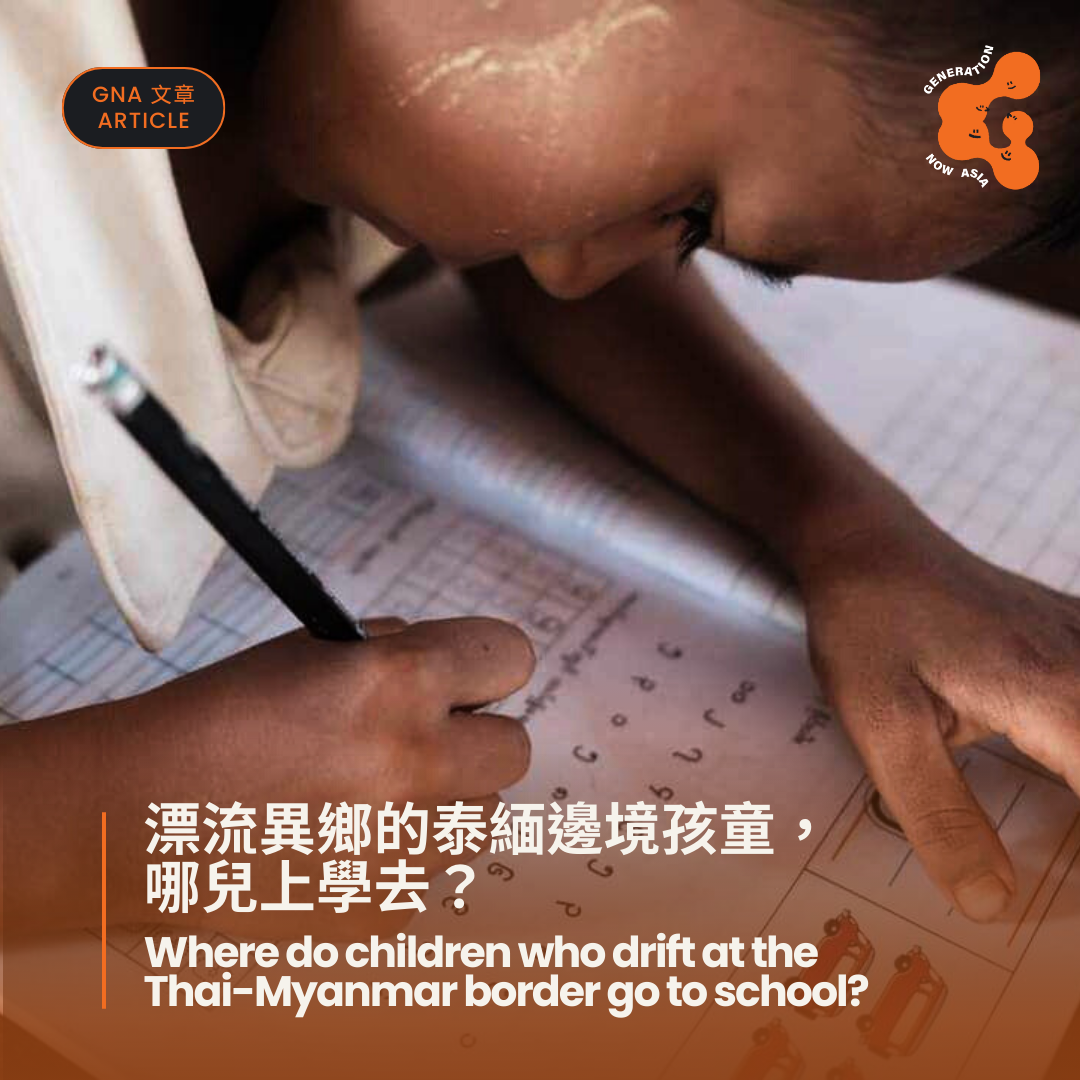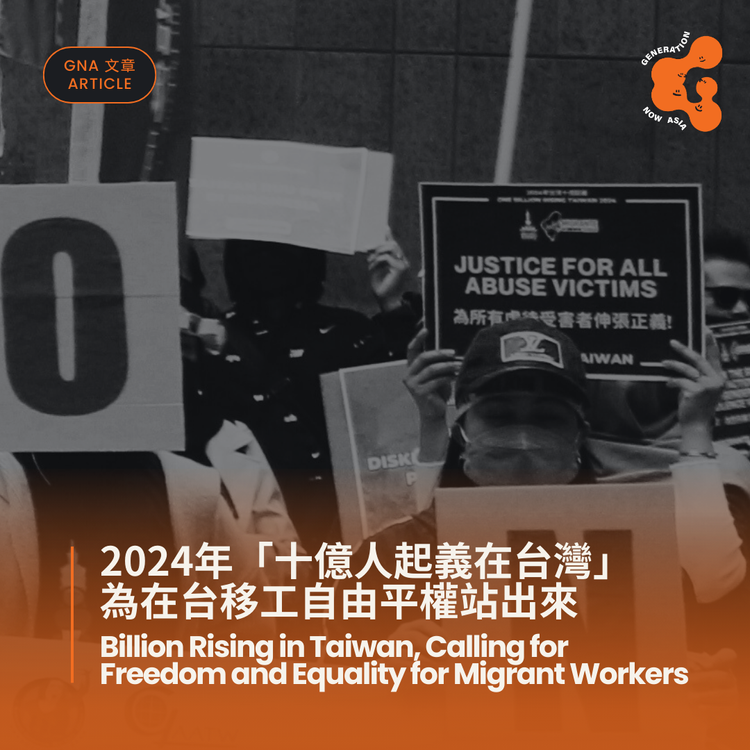【漂流異鄉的泰緬邊境孩童,哪兒上學去?】 Where do children who drift at the Thai-Myanmar border go to school?

作者:李瑞珠
「一間間用竹片、鐵片、塑膠布搭建而成的臨時的『家』,散落在廣袤的田野間。天還未亮,不到 7 歲的孩子就得跟著爸媽到農田裡工作,在烈日下採收馬鈴薯、花生、辣椒等季節性作物;較小的孩子,則獨自在家做家事及照顧更年幼的弟妹,等待家人回來。而所謂的『家』,是會隨著季節遷徙流動的,這一季農作物採收完了,就會換到下一塊田地持續採收其他農作物。」
這是正在發生的事,泰緬邊境的移工孩童,很難有機會上學,稍有能力就得出門工作,因為他們的父母大多是來自緬甸底層社會的無身份移工。
緬甸政治經濟動盪 人民紛紛出走泰國
位於泰國西北方的達省美索 (Mae Sot, Tak Province),隔著湄河(Moei River)與緬甸苗瓦底 (Myawaddy) 緊鄰對望,約 20 萬緬甸人民生活在這個城鎮及邊境鄰近地區(IOM, Nov 2023) ,因此美索也被稱為「泰國裡的小緬甸」。
緬甸過去長期內戰及軍事執政,造成經濟發展停頓,缺乏工作機會。相對緬甸不穩定的局勢,鄰近的泰國美索位於經濟貿易特區,許多外資設廠於此,大量的工廠及農田缺工,一推一拉之下,許多緬甸人民偷渡或合法來到泰國邊境,從事農務、幫傭、建築、工廠... 等粗重勞力工作,收入有限且不穩定,僅能勉強維持溫飽。
根據 2021 年人口統計,緬甸人口約 5,380 萬人,在泰國的緬甸移工就高達 250 萬人(UNDP, Nov 2023),軍事政變後的緬甸情勢更加嚴峻,失業人數增加、物價上漲,為了逃難及生存,來到美索的緬甸人民比起以往更多了。
聯合國估計 2021年軍事政變後,緬甸全國約 1,860 萬人需要人道援助,而境內流離失所人數更增加至 260 萬人,3 年來約有 48,000 多人為逃避戰火及軍方追捕而入境泰國,其中包含許多參與公民不合作運動( Civil Disobedience Movement, CDM)的人民( The Irrawaddy, Mar 2024;European Commision, Jan 2024 )

上學路迢迢 有學校卻不一定能上學
泰緬邊境有超過 5 萬孩童,想上學卻很難有機會,即使有機會也未必能上學。
或許你我會有疑問,泰國不是有學校嗎?即使泰國政府開放讓緬甸孩童能就讀泰國學校,但實際情況卻是―大部份的孩童仍因下列四大因素,而無法就讀泰國學校。
第一是「家境貧困」,從事低技術的勞力工作,微薄薪資僅能勉強糊口,當溫飽都難以維持,更沒有力氣再替孩子負擔教育費用。
第二是「交通不便」,邊境移工多從事農務工作,依傍著農田工廠,居住地偏逺且位置分散,距離學校路程遙遠,若欠缺交通工具,孩子的上學之路充滿危險。
第三是「語言隔閡」,緬甸孩童大多不熟悉泰語,若就讀泰國學校,不僅須負擔學雜費用,孩子更難以吸收課程。此外,語言及文化隔閡可能導致緬甸孩子在學校面臨歧視。
第四是「家庭需求」,當家裡大人必須外出賺錢,許多孩子沒有合適去處,只能留在家中照顧幼小手足,或帶著孩子一起外出打工,分擔家計。
掉落在保護網外的失學孩童
孩童一旦失學,連帶著也將失去保護自己的能力。
第一是「成為童工」,孩子可能被迫推向就業市場,或從事高危險工作,如:毒品販售、性工作等,對孩子的身心靈產生永久傷害。
第二是「不識字影響未來就業」,孩子未來將會缺乏選擇工作的機會,更可能因沒有保障自身工作權益的意識,面臨雇主的剝削及不公平對待。
第三是「被人口販賣」,經濟貧困的孩子,沒有學校提供保護和知識,若單獨留在家中或可能被貧窮所逼,成為人口販賣集團覬覦的對象。

重重困難下透出曙光 緬甸人民自發辦學
「日子再苦,也不能犧牲下一代的教育!」
絕地逢生的希望是來自於「當地社群自發性的動力」,有一群同樣來自緬甸的熱心人們,不捨失學孩子成為童工的困境,即使資源貧脊,仍然憑著過人的意志力,硬是在農田中、工廠邊、看不見的城鎮邊緣,用著竹片、鐵皮、木板,為孩子架起簡易的教室,從志工老師開始,陪伴著一雙雙渴望學習的眼神。
雖然稱之為「學校」,卻是非正式教育機構的緬甸移工兒童學習中心(Migrant Children Learning Centers),缺少政府的支持,教師薪資、校地租金、教材費用、教學設施、校車、水電費...等辦學經費只能靠自己四處奔波張羅。每一年都在擔心著,明年學校是否還能存活 。
在美索地區,曾經超過 80 所緬甸移工子女學校,支撐著無數孩子的上學夢。
因為教育 在異鄉綻放出閃亮光芒的師生
自 2022 年來,我曾陸續數次前往泰緬邊境,探訪由台灣邊境行動協會資助的瀑布學校及 48 公里學校。
這一天,瀑布學校裡 20 歲出頭的小潘老師正領著五年級學弟妹們,大聲拼讀英文單字,這些基礎知識,將為流離異鄉的孩子,開創實踐夢想的機會。
「我喜歡教書,能回來自己的學校當老師很開心!」小潘老師漾著羞澀的笑容,開心說出夢想成真的喜悅。曾是瀑布學校的學生,畢業後憑著緬甸移工子女學校所授予的學力證明,回去緬甸繼續升學,一路念到大學。歷經緬甸疫情及政變,心中始終掛念母校的她,決定再度跨越國界,回到泰緬邊境擔任老師。
而另一間 48 公里學校裡的孩子,正在運用令人驚豔的色彩天份,努力繪出他們的夢想。
「我想當裁縫師!」、「我想當醫生!」、「我想當足球員!」孩子們手中揮舞著繽紛的色彩,綻放笑容開心地說著。每一個人的夢想都值得被珍惜及看見,因為能夠上學,學校成為後盾及翅膀,孩子更可以大膽放手地想像著未來,並且朝著夢想直奔而去。
而今,邁入緬甸政變後的第四年,軍政府與抵抗勢力衝突未歇,社會經濟仍然動盪不安。緬甸政府將在 4 月潑水節後實施的徵兵制 (The Irrawaddy, Feb 2024),更掀起一股出走浪潮,前往泰國的緬甸人持續洶湧而至。而泰緬邊境流離孩子的教育需求,也將隨著人數不斷攀升的緬甸人民,有增無減。

Where do children who drift at the Thai-Myanmar border go to school?
by Kiwi Lee
Many temporary homes are constructed by bamboo, iron sheets and plastic sheets scattered across vast fields. Before dawn, many children must go to work with their parents in the fields, harvesting seasonal crops such as potatoes, peanuts and chilli under the scorching sun. Children under the age of 7 stay at home alone, doing household chores and taking care of younger siblings, waiting for their families to return. These homes are mobile and migrate with the seasons; once one season's crops are harvested, they will move to the next field to continue harvesting other crops."
This is the reality for Myanmar migrant children at the Thai-Myanmar border. They have limited opportunity to go to school and must work if they have the ability because their parents are mostly undocumented migrant workers from the economically disadvantaged groups.
Political and economic turmoil in Myanmar causes people flee to Thailand.
Located in the northwest of Thailand, Mae Sot, is home to approximately 200,000 Burmese people, living in the town and surrounding border areas (IOM, Nov 2023), earning it the nickname "Little Burma" in Thailand.
Due to the prolonged civil war and military control in Myanmar, economic development has stagnated, leading to a lack of job opportunities. In contrast to Myanmar's instability, Mae Sot - located near an economic trade zone - has attracted considerable foreign investment, resulting in numerous factories and farms facing labor shortages. Consequently, many Burmese people have migrated to the Thai border, either illegally or legally, to engage in labor-intensive work such as agriculture, domestic work, construction and factory jobs. However, their incomes are limited and unstable, with them having barely enough to sustain their basic needs.
According to 2021 population statistics, Myanmar's population is approximately 53.8 million, and around 2.5 million Burmese migrant workers work in Thailand (UNDP, Nov 2023). Following the military coup in 2021, the situation in Myanmar has become more severe with increased unemployment and rising prices. As a result, more Burmese have fled to Mae Sot hoping for a better chance of survival.
The United Nations estimates that after the military coup in 2021, approximately 18.6 million people nationwide in Myanmar require humanitarian assistance, with the number of internally displaced persons increasing to 2.6 million. Over the past three years, more than 48,000 people have fled to Thailand to escape conflict and military persecution, including many who participated in civil disobedience movements. ( The Irrawaddy, Mar 2024;European Commision, Jan 2024 )

The journey to school is long and challenging, and even when there are schools available, not everyone can attend.
At the Thai-Myanmar border there are over 50,000 children who wish to go to school but face significant barriers. Even if there are opportunities, they may still not be able to receive education.
You may wonder, doesn't Thailand have schools? While the Thai government allows Myanmar children to attend Thai schools, the reality is quite different. The majority of children are unable to attend Thai schools due to four main factors:
- Poverty: Many families engage in low-skilled labour jobs with meager incomes that barely sustain basic needs. They cannot afford education expenses on top of struggling to make ends meet.
- Inconvenient transportation: Myanmar migrant workers often work in agricultural fields, factories and remote areas. The distance to schools is long and dangerous, especially without access to transportation.
- Language barriers: Most Myanmar children are not fluent in Thai. Even if they attend Thai schools, they struggle to pay school fees and may have difficulty understanding the curriculum. Language and cultural differences can also lead to discrimination in schools.
- Family needs: When adults in the family have to work to earn money, many children have no choice but to stay at home to care for younger siblings or go to work with their parents to contribute to the family's income.
Children who fall outside the safety net and are unable to attend school.
Once children drop out of school, they also lose their ability to protect themselves.
Firstly, they may be forced into child labor or engage in high-risk activities such as drug trafficking or sex-work, causing many permanent physical, mental and emotional harm.
Secondly, illiteracy affects future employment opportunities. These children may lack the chance to choose their jobs and may face exploitation and unfair treatment from employers due to their lack of awareness of their own labour rights.
Thirdly, they may become targets of human trafficking. Economic poverty combined with lack of protection and knowledge from schools can leave children vulnerable. If left alone at home or compelled by poverty, they may become targets for human trafficking groups.

Amidst significant challenges, a glimmer of hope emerges as the people of Myanmar take it upon themselves to establish schools.
Mr. Aung Win, the headmaster of Nam Tok school (one of migrant children learning center), said "Even in the toughest times, we cannot sacrifice the education of the next generation!"
The glimmer of hope arises from the spontaneous drive of the local community. A group of passionate individuals from Myanmar, unwilling to accept the plight of children forced into child labor due to lack of education, have taken it upon themselves to establish makeshift classrooms in the fields, near factories and on the outskirts of unseen towns. Despite scarce resources, they rely on extraordinary willpower to construct these simple classrooms using bamboo, iron sheets and wooden boards. Starting with volunteer teachers, they accompany eager eyes yearning to learn.
Though referred to as "schools," these are actually informal educational institutions known as “Migrant Children Learning Centers”. Lacking government support, these centers struggle to cover expenses such as teacher salaries, rent, teaching materials, facilities, transportation and utility bills. Every year there is concern whether the school can survive the next year.
In Mae Sot area there were once over 80 Migrant Children Learning Centers supporting the dreams of countless children of migrant workers.

Because of education, teachers and students shine brightly with brilliance.
Since 2022, I have visited Mae Sot several times to visit Nam Tok School and 48 KM School, both supported by Glocal Action Taiwan, an organisation which focuses on helping children along the Thai-Myanmar border who don’t have access to education.
On 13th December 2022 , Teacher Pan, who worked in Nam Tok School in his early twenties, was leading G5 students loudly teaching them how to spell in English. These foundational language skills provide greater opportunities for children who are displaced to pursue their dreams.
"I love teaching, and I'm very happy to come back to my own school as a teacher!" Teacher Pan said with a shy smile, expressing the joy of realising her dream. Once a student of Nam Tok School, she graduated and returned to Myanmar with the academic credentials provided by the Migrant Children Learning Centers, continuing her education all the way to university. Despite facing the challenges of Covid-19 and the regions unstable political situation, she decided to cross borders again to teach in Nam Tok school at Thai-Myanmar border.
In another school, the 48 KM School, I observed children drawing their dreams with their artistic talents:
"I want to be a tailor!" "I want to be a doctor!" "I want to be a football player!" The children drew their dreams with colourful crayons, expressing their wishes with smiles and happiness. Every dream deserves to be cherished and seen, because with the opportunity to go to school, the school becomes a support and a guiding wing, allowing children to boldly imagine their future and pursue their dreams.
Now, entering the fourth year after the Myanmar coup, conflicts between the military government and resistance forces still continue, and the socio-economic situation remains unstable. The announcement by the Myanmar junta calling for the national conscription law to be enforced requiring young people (men aged 18 to 35 and women aged 18 to 27) to serve for up to two years in the military (The Irrawaddy, Feb 2024) has sparked a wave of new emigration, with increasing numbers of Burmese flocking to Thailand in hope of escaping being called up by the junter. The educational needs of displaced children at Thai-Myanmar border will only increase with the growing number of Myanmar people coming to the borderland.
Source: Glocal Action Taiwan 邊境行動協會



